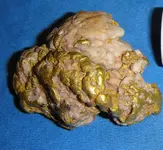gold nuggets on the ground all over, placerville has gold under the streets too, albert at the hardware store was the first to pan it a few years back when they repaved everything. He thought the city should have bagged it and sold it as pay dirt! He showed me the gold he got from that and it was ridiculous. Gold is where you find it in our area streets.......
http://fox40.com/2015/03/20/gold-found-during-placerville-main-street-upgrade/
after this big 25 year storm everyone should check their patches
 Streets of Gold Rush towns once lined with gold;
Streets of Gold Rush towns once lined with gold;
This happened in the “Good Old Days,” a beautiful and lavishly prosperous time in our foothills when hard rock mining was at the top of its game, unemployment was virtually zero, and, notwithstanding ill-luck, those with the entrepreneurial spirit could still strike out on their own and make a respectable living by washing gold in the Mother Lode’s placers.
In Sonora, as with many California cities built over alluvial soil, there was a curious group of townspeople known as “pickers” who waited for cloudbursts, then rushed into the streets to gather up small gold nuggets and chispas exposed by the rain.
Hardly a storm went by without at least two or three stories told as truth of pickers doing exceedingly well. In the winter of 1897, for instance, a picker was said to have taken five sizable nuggets from Sonora’s streets and gullies, yielding approximately $280,000 based on today’s inflated precious metals market.
That same year a Sonora man plucked an eight-pound nugget out of the mud from in front of the City Hotel, and another lucky picker spotted a six-pound lump in front of the Long Tom Saloon.
So numerous are stories of pickers’ amazing finds that they would never fit in the narrow space of a newspaper article. Shall we hear more?
Back in 1857 - a banner year for pickers - a loiterer behind the Wells’ Fargo & Company’s express office in Sonora found a 14-pounder lodged in the mud, less than an inch from the surface.
Another rain storm yielded a nugget of similar size from in front of Sonora’s livery stable on Washington Street. And finally this: One wet morning in 1888, or thereabouts, a Sonora lady spotted a 2 1/2-ounce nugget on her way to church.
She dropped it in the collection plate, or so it is legended, prompting the minister to end his sermon by saying, “It is not sinful to look for nuggets on the Sabbath, provided what is found is given to the service of the Lord.”
Interestingly enough, a pickers’ work was made easier in the Good Old Days owing to several contributing factors. First, there was the pulverizing effect. A steady stream of wagon traffic through Sonora’s busy streets ground up rocks and boulders like a stamp mill.
Secondly, heavy rains turned wheel ruts into mini sluice troughs, similar to those used by miners working their claims in the diggings.
Thirdly and most importantly, Sonora’s main thoroughfare was surfaced on a regular basis with tailings from the world-famous Bonanza pocket mine.
Learned scholars have since speculated that approximately ninety percent of Sonora’s hidden treasure still remains in the ground, by the way, and a mere fraction of her vast yellow wealth came out of the Bonanza.
The now-sealed off entrance to this unparalleled gold mine is situated on a hillside behind St. James Episcopal Church, overlooking Sonora High School.
In 1879, at the height of its glory, the Bonanza’s daily production was kept a close-guarded secret, but its total activity over some 100 years of existence has since been estimated by knowledgeable persons at $3.5 million - $119 million based on present market values.
All things good eventually come to an end, it is said, and so it was that the great Bonanza eventually played out and was abandoned in November of 1898. After numerous failed attempts to once again make it profitable over the next 50 years, it was finally sold to PG&E in 1948, its gallows frame torn down in 1953, and its shafts, tunnels and crosscuts allowed to fill with water permanently.
But I digress.
Back on the streets of Sonora, townsfolk had a field day up until 1924, at which time the city’s main thoroughfares were paved over with a crude form of asphalt to accommodate horseless carriages. Result: Pickers became a dying breed soon after this.
Today, unlikely stories of streets lined with gold are vivid reminders of Sonora’s fabulous Good Old Days — a fleeting era in the Old West to return no more.






